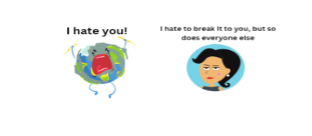“The lowest common denominator is Reality TV”
– Cameron Tucker, Modern Family
The Kardashians have nothing over climate change. Their content is limited to a personal feud over dresses and boyfriends while this reality tv which has been spanning over decades now, gives something new to see every day. People believe it’s only comedy – turning on Acs during November and having leopards enter schools, but people forget the horror part – having 11,290 farmers commit suicide over crop failure due to erratic monsoon and heatwaves claiming 360 lives in India, alone. People underestimate the all-in-one nature of this reality tv.
And it’s time we stop doing that, even more so after it has been confirmed that global warming exceeded 1.5C between February 2023 to January 2024.
Majority feign ignorance or lack awareness, believing climate change to affect only a handful of areas, considering it to be a threat mostly to the bio-diversity aspect of it and while that is a valid concern, the impacts are far more intricate.
“Climate change has caused substantial damages, and increasingly irreversible 75 losses, in terrestrial, freshwater, cryospheric and coastal and open ocean ecosystems (high confidence). The extent and magnitude of climate change impacts are larger than estimated in previous assessments (high confidence).”
– AR6 Synthesis Report, 2023, Intergovernmental Panel on Climate Change (IPCC)
Climate Change and Women

Society does not go easy on women and neither does climate change. Climate change subjects agrarian countries like those in Africa and Asia to erratic monsoon, droughts and other natural disasters which leads to crop failure and ultimately perpetuates a vicious cycle of poverty.
To cope with poverty, girls are either married off early or forced to drop out of school. Girls are the ones to suffer the most and recover the last. Poverty stricken families often have the young girls engage in household chores rather than focusing on their education. Girls get raped and sexually harassed while being forced to work such jobs in other affluent homes. Intensifying droughts and aridity increase child marriage and adolescent birth rates. According to UN Women, environmental variables such as aridity affect adolescent birth rates and in Cambodia, child marriage rates are increasing with the frequency of drought episodes. Women during pregnancy are also often at high risk due to unpredictable natural disasters which might compromise access to healthcare, the likelihood of stillbirth because of heat stress and limited access to clean water and environment especially in underdeveloped areas.
It has globally been recognized that women leaders are more efficient often contributing to greater cooperation and sustainable peace. Karen Davila, UN Women National Goodwill Ambassador believes in the need for women climate journalists, “To expose untold narratives, to support climate and human rights defenders, to challenge gender stereotypes, uncover stories of discrimination and inequality, to ensure gender diverse voices are represented in climate coverage and to drive accountability through feminist climate action.” Conventional women traits such as sympathy and sensitivity have led them to understand climate change at a greater and more personal level than men, in general.

From the above data, it can be deduced that women in countries such as Australia, Canada and U.S.A believe it is necessary to make lifestyle changes in order to reduce the impacts of climate change.
Climate Change and Mental Health

You don’t need Freud to understand how climate change affects your mental health. Beyond its physical manifestations, climate change also brings about significant impacts on the psychological health of people. Why is it that most of us prefer fall or winter over summer?
It’s more than just wanting to drink pumpkin spice latte and having fall inspired outfits on Pinterest. The heat irritates us. In order for us to adjust to the high temperatures, the hypothalamus in our brain works with our skin, sweat glands, blood vessels etc. in relation to external and internal stimuli so to manage our body temperature and keeping it from soaring too high or dropping too low. But higher the temperatures will be, the more will the body have to work which takes a toll on our mental health. There is evidence which state that heat waves are associated with increased anxiety, frustration and aggression. Exposure to extreme climate events during pregnancy may also make a child susceptible to mental health disorders. British Columbia’s center for Disease Control found that during heat waves, people with schizophrenia are three times likely to die. Lithium for bipolar disorder can become toxic for people if they are dehydrated. Continuous environment crisis may exacerbate existing mental illnesses or lead to the development of new ones.
A country such as India is an agrarian economy which makes most of its population dependent on water. But the current climate change has entailed severe water availability issues such as ocean acidification, thermal expansion, changing water dynamics, extreme weather, contamination which hamper the economic conditions of farmers. Some commit suicide, some are forced to work as menial labourers within improper working conditions which have a detrimental impact on their mental health and the ones who borrow money from money lenders face lifelong harassment which might force them into fleeing and living under constant stress.
Disaster prone areas have victims suffering from anxiety, stress and post-traumatic stress disorder (PTSD). “Sixty-seven percent of individuals with direct exposure to the California Camp Fire of 2018 said they experienced trauma similar to PTSD, compared with 14 percent of those indirectly exposed. These effects can last for years, as reported by those who lived through Hurricane Katrina.” says The Commonwealth Fund. Similarly, a 10-nation survey found that children between the ages of 16 – 25 often worry about climate and 45% among them believe those worries negatively affect their daily lives.

Climate Change and Social Justice

Social justice has 4 key principles – Access, Participation, Human Rights and Equity. It goes without saying that as long as climate change exists, so will social injustice. The poor will live in a hand-to-mouth manner, none of the vulnerable communities will have adequate representation or a say in policy making, basic rights will keep on being violated and equity will remain a utopian concept.
“Climate justice begins with an acknowledgement that the effects of a changing climate are not distributed equitably.”
– WWF
Climate change has affected those who have contributed the least towards it. Indigenous people do not only depend on the natural environment, which is slowly eroding, for their essentials but have revered the nature as an important aspect of their cultural practice. IPCC in its AR6 Synthesis, 2023 report concluded that “Cultural losses, related to tangible and intangible heritage, threaten adaptive capacity and may result in irrevocable losses of sense of belonging, valued cultural practices, identity and home, particularly for indigenous people and those more directly reliant on the environment for subsistence.” Climate change also significantly aggravates already existing inequity. Human influenced climate change cause cyclones and wildfires which lead to destruction of economic valuables, productive assets and health security.

Home page of Reuters Environment, 2024
Climate change accelerates the happenings of natural disasters and vulnerable communities are bearing the brunt of it. The sea level rises 0.1m higher at 1.5C which is making countries increasingly prone to floods. In Morocco, the gradual loss of the oasis ecosystem is threatening the nomadic lifestyle of the indigenous people there while the crop failures in Iraq have made Ahwari women unable to sustain themselves. (Source: GREENPEACE). In India, the pace of deforestation has fastened under the Modi Government. The forest policy drafts, by the government had faced backlash twice in 2016 and 2018 for ignoring the rights of tribal people and forest dwellers and allowing an opening for corporate exploitation of the forests. The consequent destruction of the homelands of the indigenous people forces them to migrate into urban areas which puts them on the receiving end of discrimination and prejudice. “Moreover, 70–80 per cent of the more than 370 million indigenous peoples worldwide are spread across Asia and the Pacific, a region particularly vulnerable to the impacts of climate change.”- International Labour Organisation Even after facing such severe consequences, they have been excluded from the decision-making processes and lack institutional support.
This limits their access to remedies, increases their vulnerability to climate change, undermines their ability to mitigate and adapt to climate change, and consequently poses a threat to the advances made in securing their rights.
Parts of East Africa suffered one of the worst droughts in 40 years putting more than 20 million at the risk of severe hunger. It is believed that millions of people will be at risk of climate risks and poverty by 2050.
Climate change doesn’t only mean feeling abnormally hot during off-seasons, farmers drowning in poverty and animals suffering habitat loss, it also means for a wife to see her child being killed by an untimely flood, it means for a farmer to see his months of hard work being swept away by the cyclone, it means for a domestic house help to not be able to sleep at night because of the extreme heat.
If we don’t decide to stop neither will the climate nor will the drastic consequences. We should change before the climate decides to, any more.











